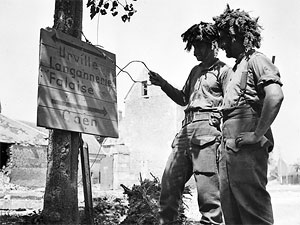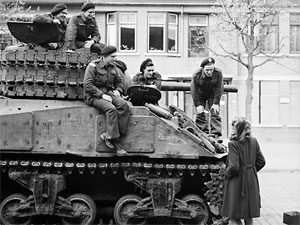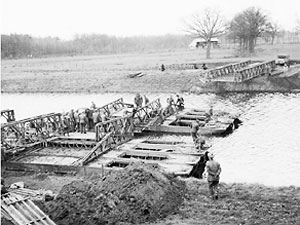Organization
- Reconnaissance
South Alberta Regiment - 4th armoured brigade
The Govemor General’s Foot Guards
The Canadian Grenadier Guards
The British Columbia regiment
The Lake Superior regiment - 10th infantry brigade
The Lincoln and Welland regiment
The Algonquin regiment
Argyll and Sutherland Highlanders of Canada - Support
New Brunswick Rangers - Artillery
15th field artillery regiment (towed)
23th field artillery regiment (self-propelled)
5th anti-tank regiment
8th light anti-aircraft regiment - Engineers
- Signals
- Services
History
The units which were going to constitute the 4th Canadian armoured division were mobilized in September 1940. At the time of its creation, 4th Canadian division was supposed to become an infantry unit, and it was trained as such for the two following years. It is no sooner than in 1942 that the federal government of Ottawa took decision to convert this division into an armoured force. This reorganization was carried out in record time – no more than five months – by Canadian armoured warfare specialist gen. Worthington, then the 4th armoured division was transported to Great Britain in two shipments, between August and October 1942. It is thus on the British ground that 4th Canadian division finished its training and was equipped with new weaponry.
In Normandy
Fourth Canadian armoured division landed in Normandy at the end of July 1944 and integrated First Canadian Army. Its first battles would occur in the struggle which was opposing 2nd Canadian Corps to German defenses on the road from Caen to Falaise – it means the difficult operations Totalise and Tractable.
In the context of Totalise, 4th armoured received mission to break through German lines, softened by initial artillery pounding and attacks of 2nd Canadian ID. 4th brigade led the attack, which began in the afternoon of August 8th, but the lack of experience of Sherman crews, who encountered enemy for the first time, as well as strong German resistance, brought disappointing results. Furthermore, even before the start of the attack, rearguard of the division was bombed by mistake by US heavy bombers… Suffering significant losses, Canadians carried out a poor performance, and failed to achieve the planned breakthrough. Worse, wishing to deliver an unexpected blow behind german lines, an armoured column of the British Columbia lost its way in the night of August 8th to 9th and arrived in the middle of 12. SS-PzD, where it was practically annihilated – survivors were recovered in the afternoon by the 1st Polish armoured division.

From the Seine to the Scheldt

The 4th armoured division crossed the Seine, reached Saint-Omer on September 5th, then entered in Belgium the following day, hustling Germans from Ypres. It was then organized in two tactical groups – the Stewart force and the Moncel force. It headed for Brugges, but was stopped September 8th on the Ghent channel, which bridges had been destroyed. Strong German resistance encountered alongside the channel marked the end of the phase of pursuit. In the evening, infantry of the 10th brigade managed to establish a weak bridgehead at Moerbrugge, then to reinforce it with engineers establishing a bridge.
In spite of the successful establishment of this bridgehead, operations around and beyond Antwerpen were to be prolonged, the ground being crossed by channels which limited any possibilities of broader offensive. September 13th, Algonquins (Moncel force) carried out a crossing attempt at the junction of the Leopold and Lys channels, but had to withdraw the following day after having suffered heavy losses. From September 15th, the 4th armoured division attacked in direction of Maldegem. September 21st, it was reoriented to patrol along the Ghent – Ternheuzen channel. From October 2nd, the 4th armoured division took part as support for 3rd Canadian infantry division in the fights for the Breskens pocket – a highlighted achievement was then the capture of the Isabella polder by 10th infantry brigade.
Canadian armour was then committed north of the mouth of the Scheldt, in the bloody drive of Canadian 2nd Corps to open the strategically important port of Antwerpen. On its way, it freed Bergen-op-Zoom, fled by its defenders, on October 27th. However, a reconnaissance of South Alberta and Lincoln and Wellands found the enemy firmly entrenched on the northern shore of the channel than runs immediately north of the city. Three attempts were necessary for the Argyll and Sutherland to overcome german opposition.
The capture of Bergen opened to the 4th armoured division the road towards the mouth of the Maas, to secure the right flank of the 2nd Canadian infantry division, in charge of reducing defenses of the Beveland and Walcheren islands. Fourth armoured brigade progressed towards St Philipsland. After having captured the city, it cleaned its neighborhoods, while its artillery fire sank several German boats trying to escape from the port of Zijpe. Campaign on the Scheldt finished on November 8th, with all approaches to the port of Antwerpen being cleaned from last German defenders. First Canadian ship could unload its shipment in Antwerp the 28th.
From the Maas to the North Sea
From November 8th, the 4th Canadian armoured division benefited from a deserved rest which enabled it to build up its forces, seriously depleted by more than three months of continuous fights. However, manpower shortage was to remain the weak point of all Canadian divisions, as Canadian government would never agree to oblige its citizens to fight overseas.
Finally, from February 8th, 1945, the 4th armoured division was committed in operation Veritable, again with the 2nd Canadian Corps. It supported the assault of 2nd and 3rd infantry divisions, with whom it shared the difficulties of a fight in extreme weather conditions, in mud, cold, in addition to the impenetrable forest. From February 24th, it attacked in direction of Udem and Xanten. It ran up against the furious resistance of the 116. PzD, which tried by all ways to prevent the Canadians from reaching the Rhine. It took one week of engagements to arrive for Xanten, whose approaches were defended by the parachutists of the 17. FjR. Losses were heavy, particularly within the infantry of Argyll and Sutherland Highlanders.


Once the crossing of the Rhine carried out, the 4th armoured division took the direction of the North Sea. It crossed the Twente channel near Delden, then continued its progression along the German border towards Almelo. The Dutch city was released on April 5th, then the Canadian tanks turned east to enter in Germany. In the last weeks of the Second World war, the 4th Canadian infantry division crossed Ems near Meppen, then rolled aside 1st Polish armoured division towards the ports of North Sea. On May 5th, 1945, it delivered its last fight in Oldenbourg. The 4th Canadian armoured division was inactivated in the Netherlands in 1946.










